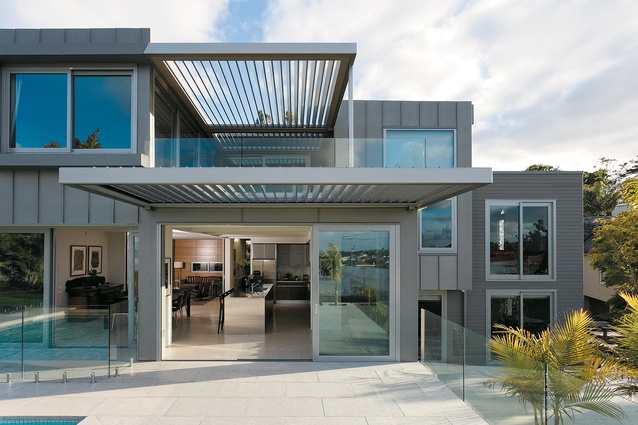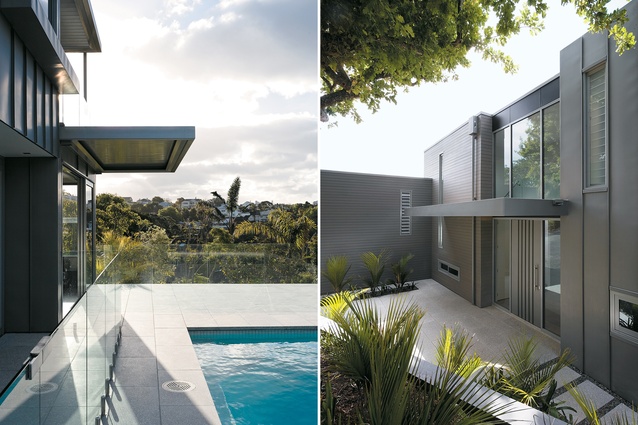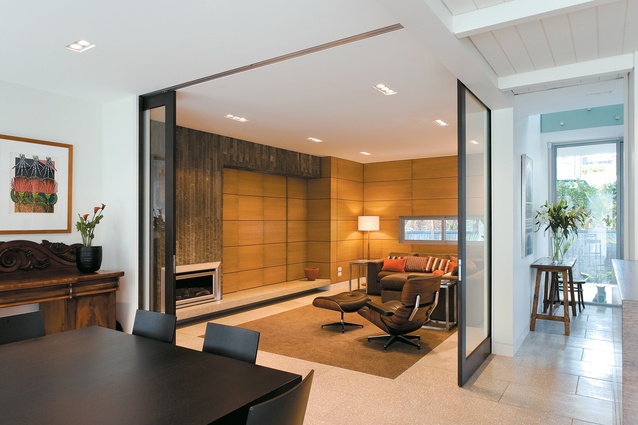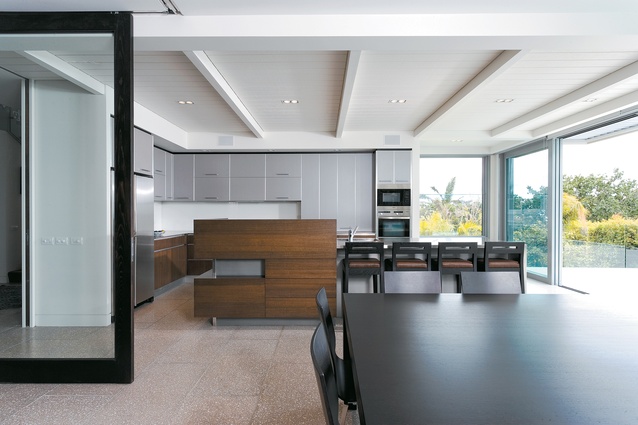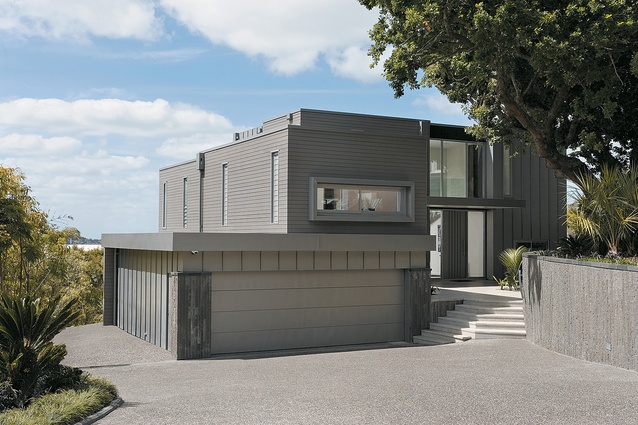Houses Revisited: Advanced pose
Xsite Architects’ zinc-clad house in a conservative Auckland suburb, first published in March 2008, stretches out to the sun and sea.
On the northern slopes of Remuera, dotted with conservative faux-Tudor and Arts and Craft mansions, an unabashedly modern, zinc-clad house is something of a surprise. Of course, a little shock can be good for the system. This house may astonish some of the more traditionally-housed neighbours, but it is this difference which makes the house seem so refreshing.
The design’s divergence from the status quo caused a lingering debate in council with fears that this modern dwelling might be an ‘eyesore’ in the posh Residential 2 suburb. The hand-wringers needn’t have worried; rather than the house brashly asserting its contemporary structure, its dark forms seem to sink into the hillside, making it much less visible than some of those mock-Tudor neighbours.
Perhaps the greatest surprise of this contemporary home is that its roots are much older than its facelift suggests. The building is a renovation (albeit a thorough-going one) of a poorly renovated 1950s house the owners bought ten years ago. Initially, the owners considered bowling over the house and starting afresh; instead they decided to work with what they’d got. While staying within some of the confines of the original plan has caused some awkwardness in places – the downstairs bedrooms in particular – it has also allowed the retention of the favoured position on site, pressing against the northern boundary to reveal prominent views across Parnell and to the Waitemata harbour.
Most of the house strains towards this view. Because the framed landscape seems to offer enough colour the interiors have been kept to a muted palette of grays. While this colour scheme creates a unified and calm feeling throughout, it could seem slightly dreary. However, a beautifully chosen stain on the Tasmanian Oak cabinetry panels in the lounge and a darker timber screen over the kitchen bench add warmth to the house.
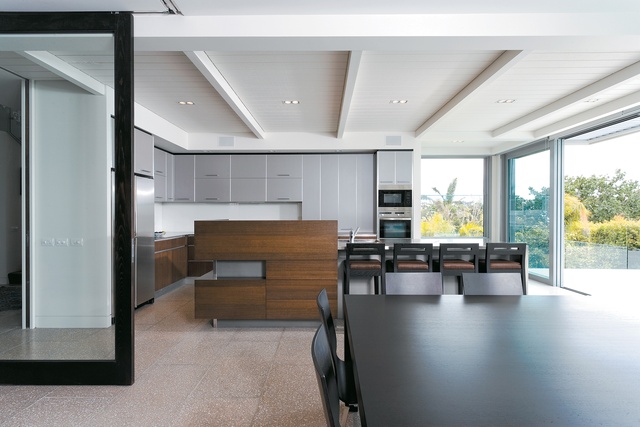
The craftsmanship in the cabinetry and the care in detailing throughout the house are where this project excels. The skirting seamlessly turns into the doorjamb; window joinery above the hall is rebated to produce a frameless view over the hills; sinks are fashioned from a single slab of terrazzo. Nothing is overlooked, nothing is too small or too simple to tweak in some way to make exceptional. It is impressive, even if the house occasionally feels suffocated by a desperation for perfection.
While a degree of tight control is necessary to gain this level of finish, it is in places, such as the entry foyer, which seem to be less obsessively doted upon in terms of materials, that the house really surprises. The wide zinc door, designed by the architect to work in with the exterior cladding, opens into a threshold sheltered by an overhead walkway. A few steps in and the ceiling above opens to a double-height space punctuated by a slowly revolving suspended artwork by Graham Bennett. The play between secluded and more exposed spaces is deftly manipulated here, creating interest in an area which, if it had been left as a single volume, would have lacked much drama.
Drama is what’s on offer in the entertainment room, dubbed ‘the cave’. This room, specifically designed for TV- and movie-watching, has a narrow window along the back wall and a lowered ceiling, and has been finished in dark colours so that it stands in stark contrast to the spacious living areas below. The shift from the airy hall to this room is slightly disconcerting, and perhaps the rigour with which this room was designed for such a single-minded purpose is a little excessive. However, the teenagers of the house would probably disagree, as they and their friends can often be found lounging here in their own private grotto.
Having spaces to suit all family members was an important design consideration. One of the clients’ key requests was for a private retreat away from the children. The master-suite was packed between the living areas below, which required a high stud, and the council height regulations above. The floor has been ingeniously compacted to a solid 20mm Vitex deck so as not to waste precious headroom.
The suite consists of a large bathroom, ample wardrobe, master bedroom, study and ‘yogarium’. The latter was the biggest surprise for the architect in the original brief. One lives and learns: the architect now knows that, yes, a yogarium is a room dedicated to the practice of yoga. This room, as with the master bedroom, looks out over the water and grants the best views in the house – an appropriate place to salute the sun.
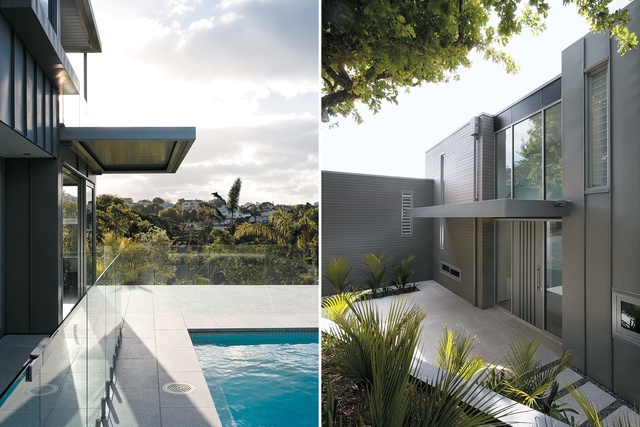
Yoga is to be recommended to anyone involved in a lengthy build. Construction inevitably occasions minor and, occasionally, major surprises. The pessimistic among us might characterise unanticipated occurrences as solecisms; the sanguine would just see them as welcome opportunities. While little leeway was left for error in this polished house, the custom-made interior doors, finished with sections of timber veneer, look unexpectedly stripy, and their appearance caused some anxiety when they were first installed. However, ever the optimist, the architect is now quick to point out that the pattern on the doors was actually fortuitous, drawing as it does the vertical language of the exterior finishes inside. And the clients concede that those same doors are features of the house that guests constantly remark upon.
This house has been precisely choreographed with each step meticulously composed to ensure a flawless performance. Applause is deserved, although the house still seems a bit stiff in its zinc collar. It will always look rather hard – how could it not? – but it seems eminently suitable to supple use.
Click here to see more Houses Revisited. And sign up to our email newsletters to receive Houses Revisited straight to your inbox.
Note that, since the time of publication, the architecture firm mentioned may have changed name, personnel or both.

